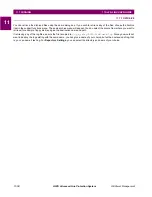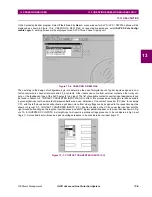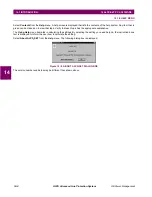
GE Power Management
ALPS Advanced Line Protection System
13-3
13 XPRESSION BUILDER
13.1 INTRODUCTION
13
The second type of timer is basically a pickup delay timer with a reset input/output feature. As shown in Figure 13–4:
PICKUP DELAY TIMER, there are two inputs, two outputs, and a user selected pickup delay (in milliseconds). In its “initial”
state with no inputs applied, both R and S are low (binary 0), the timer outputs RO and SO are both low (binary 0). The
timer starts counting when the S input is high (binary 1). When the count becomes equal to the set time delay (1000 ms for
our example), the SO output is set high (binary 1) and the RO output is set low (binary 0). If the R input becomes high
(binary 1) while the timer IS NOT counting, then both outputs RO and SO are set low (binary 0) which returns the timer to
its “initial state”. See Table 13–1: PICKUP DELAY TIMER TRUTH TABLE for a summary of the pickup delay timer function.
Figure 13–4: PICKUP DELAY TIMER
d) COUNTERS
The counter has two input line, one output line, and a user selected count threshold (in milliseconds) as shown in Figure
13–5: COUNTER. A transition from low (binary 0) to high (binary 1) on the S input line increments the counter by a value of
one. The O output line is high (binary 1) when the accumulated count is equal to or greater than the count threshold. If the
O output line is low (binary 0), then the accumulated count is less than the set value. A transition from low (binary 0) to high
(binary 1) on the R input line resets the counter to zero.
Figure 13–5: COUNTER
Table 13–1: PICKUP DELAY TIMER TRUTH TABLE
S
R
PREVIOUS TIMER STATE
CURRENT TIMER STATE
RO
SO
L
L
NOT TIMING
NOT TIMING
RO
n-1
L
↑
L
NOT TIMING
TIMING DOWN
L
L
X
L
TIMING DOWN
TIMER EXPIRED
L
H
X
H
TIMING DOWN
TIMER RESET
H
L
X
↑
NOT TIMING
NOT TIMING
L
L
1000
R
S
S O
R O
0
0
0
0
S
R
O
5







































